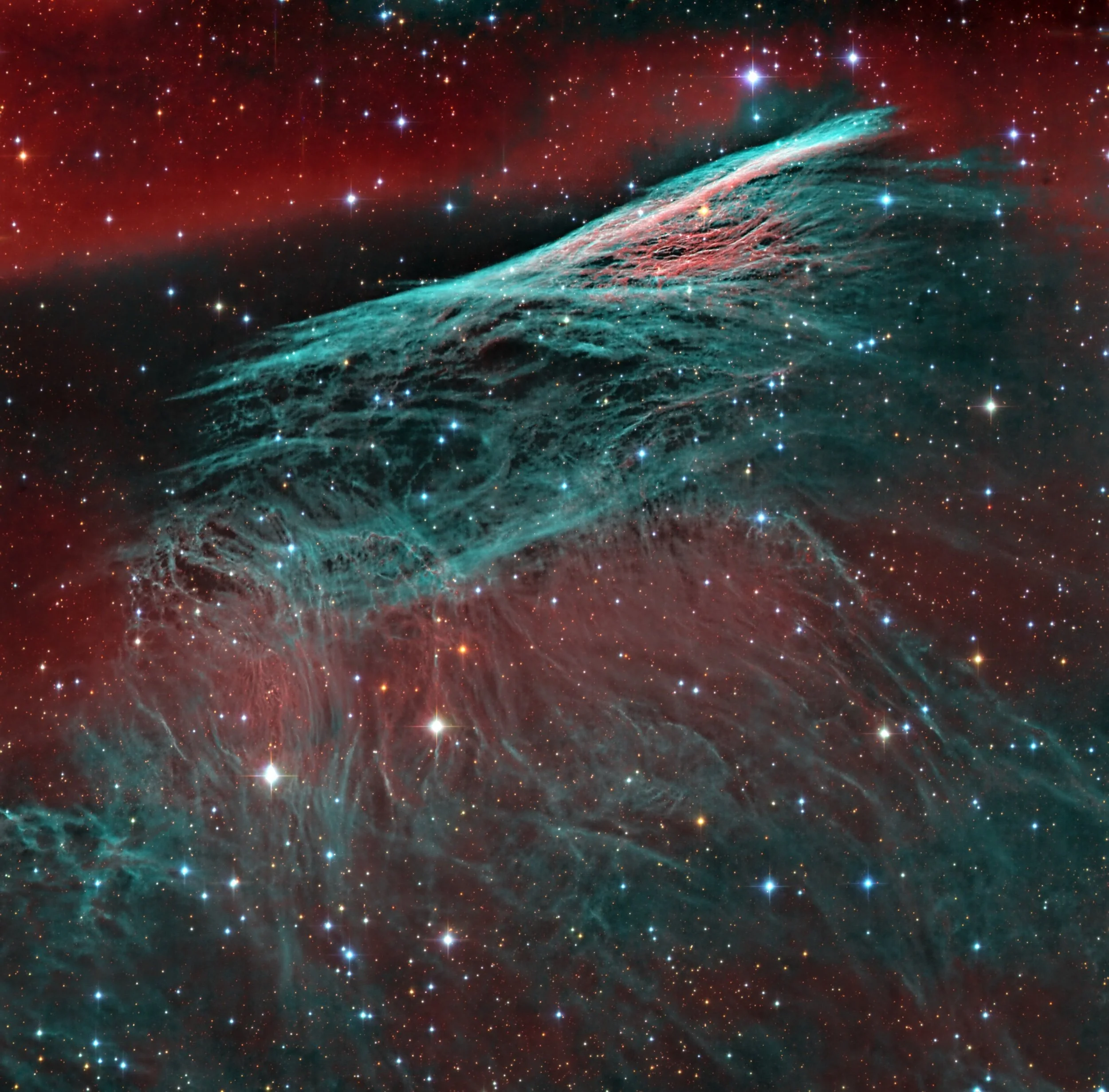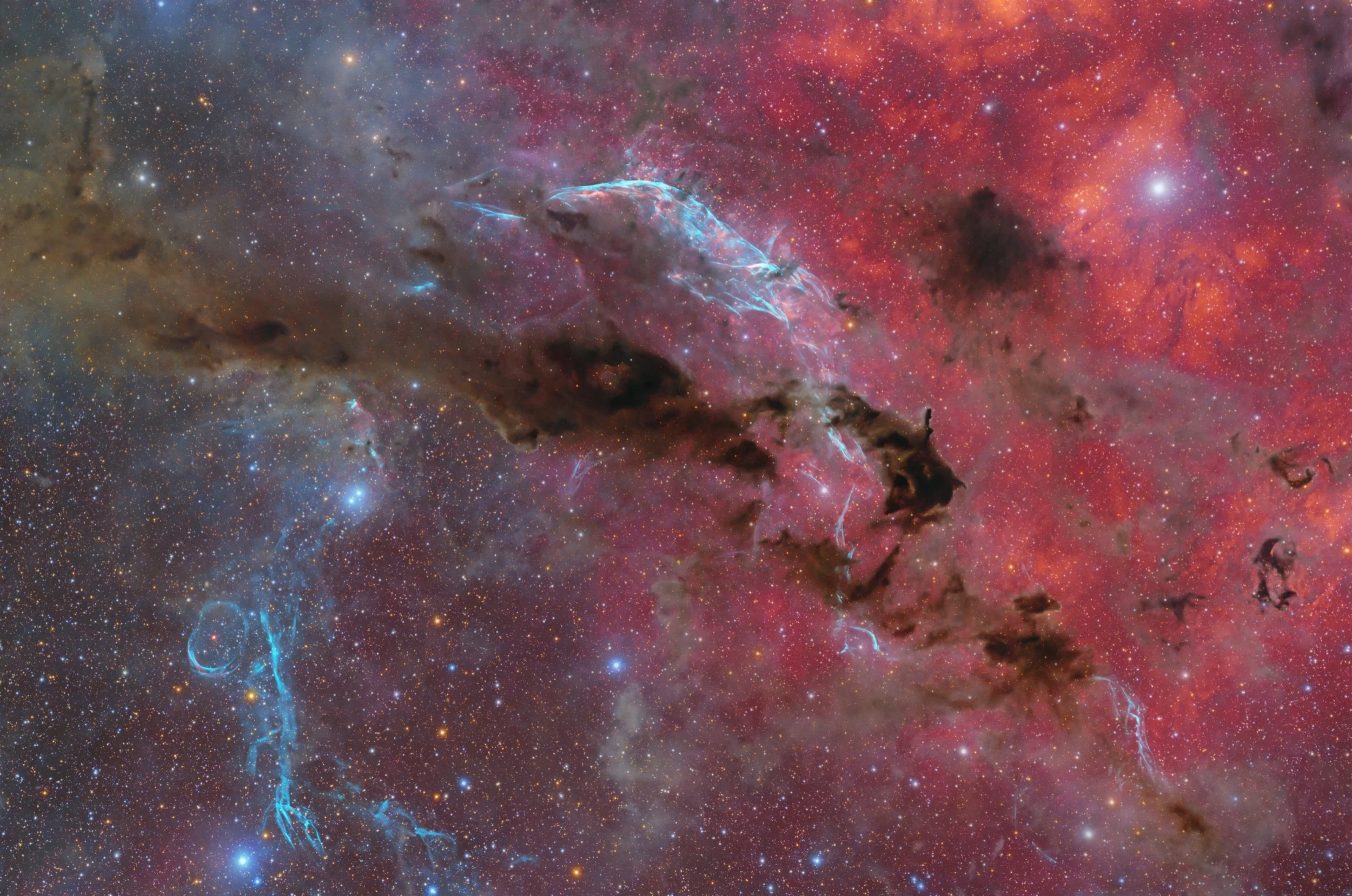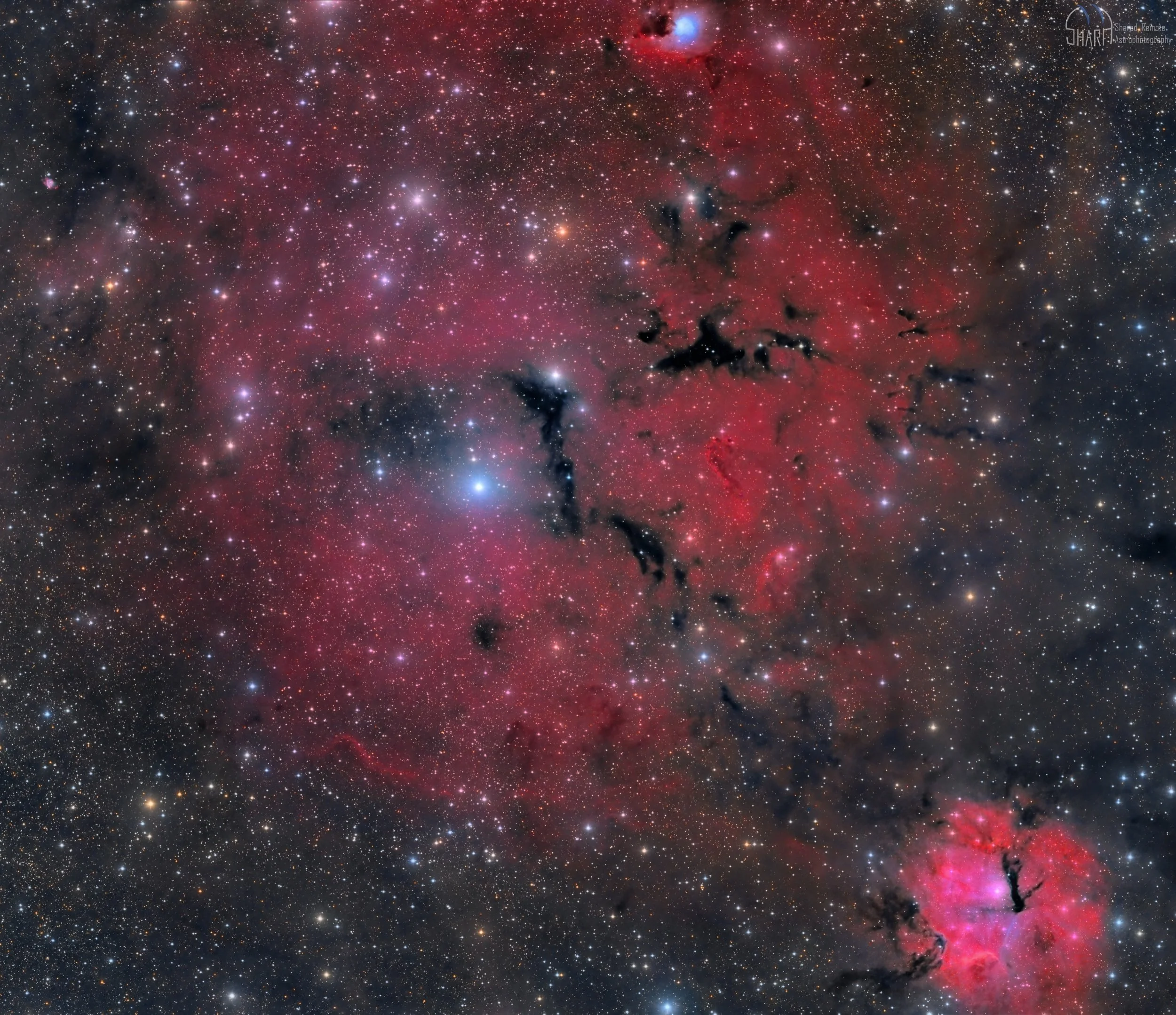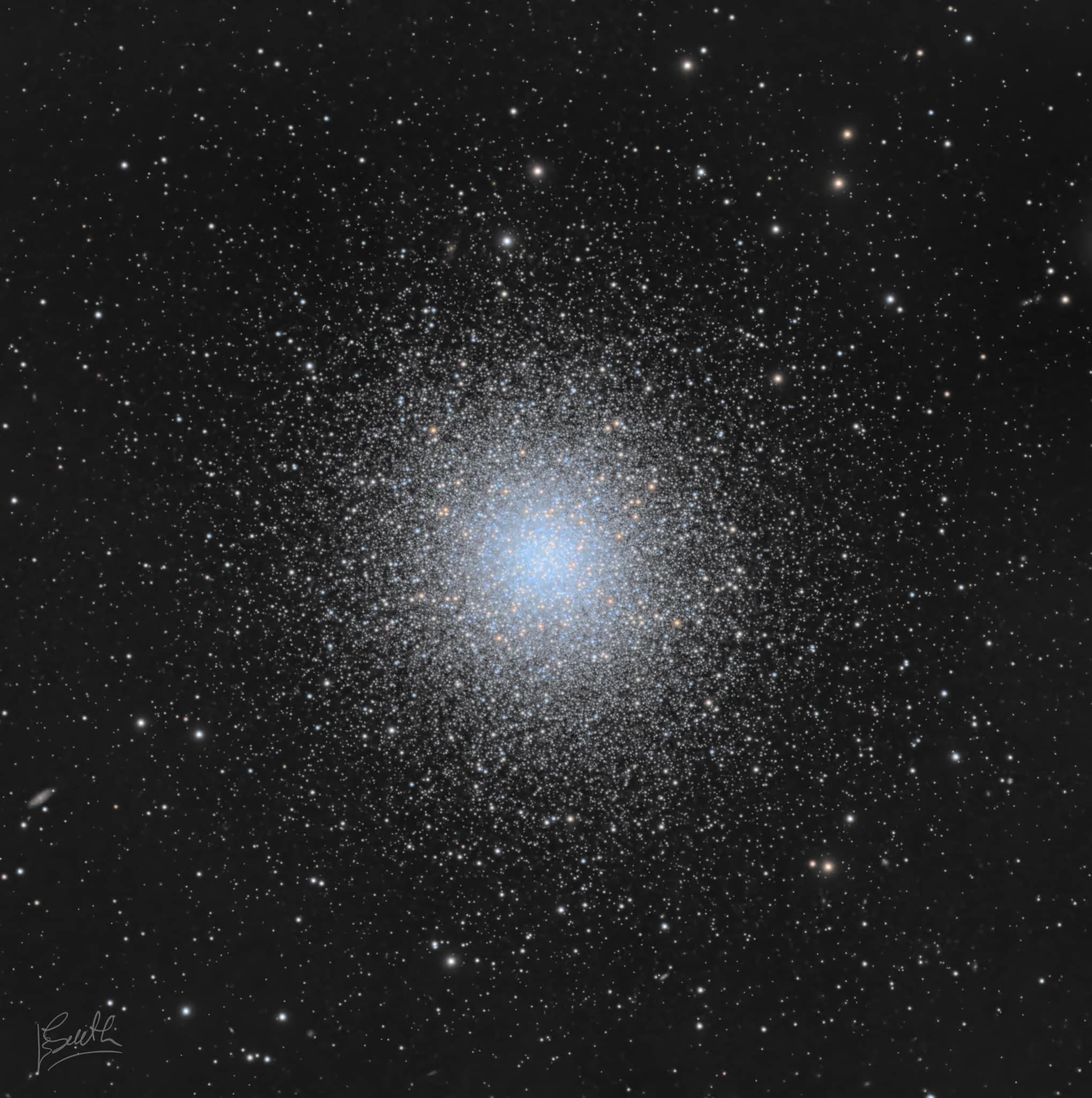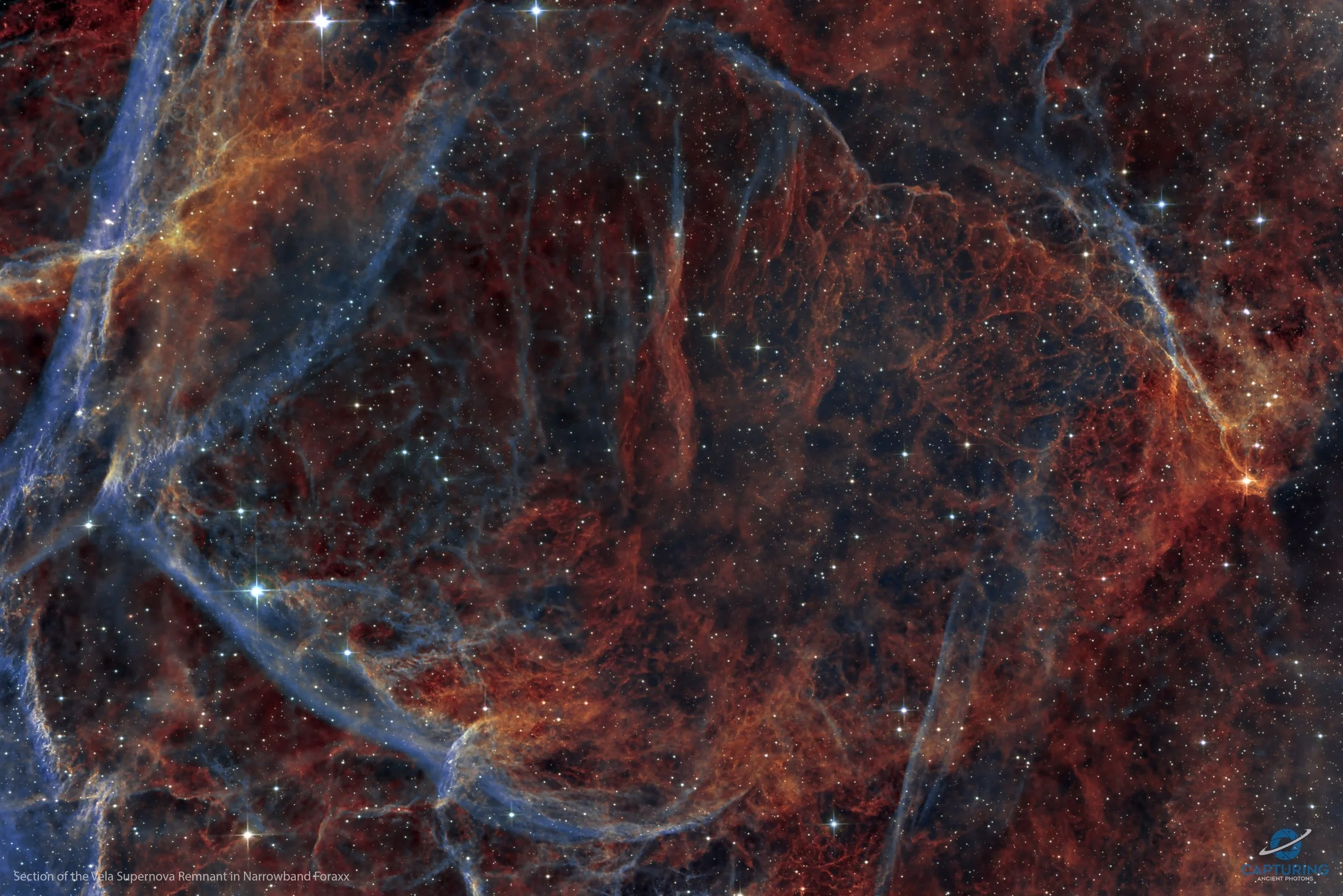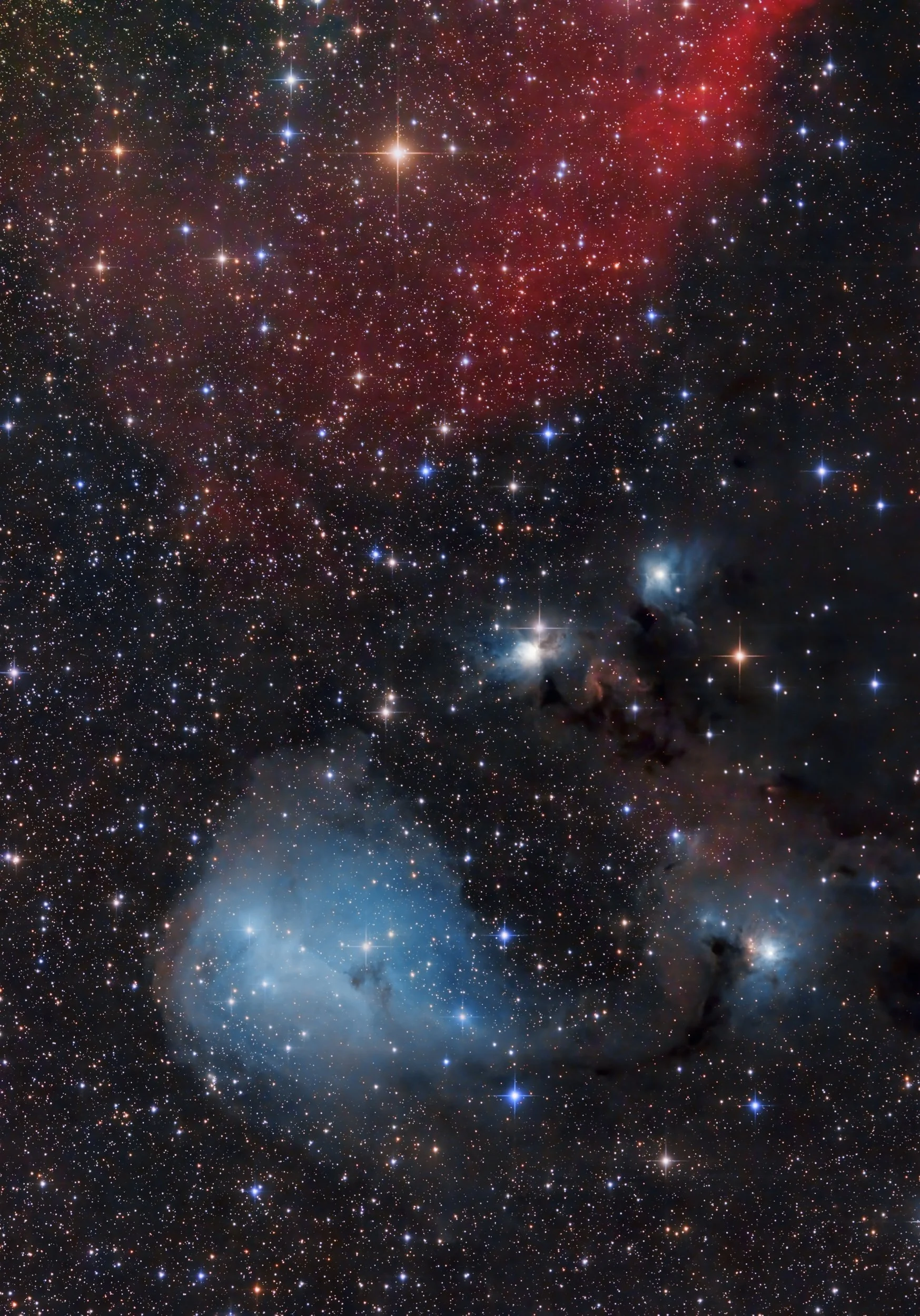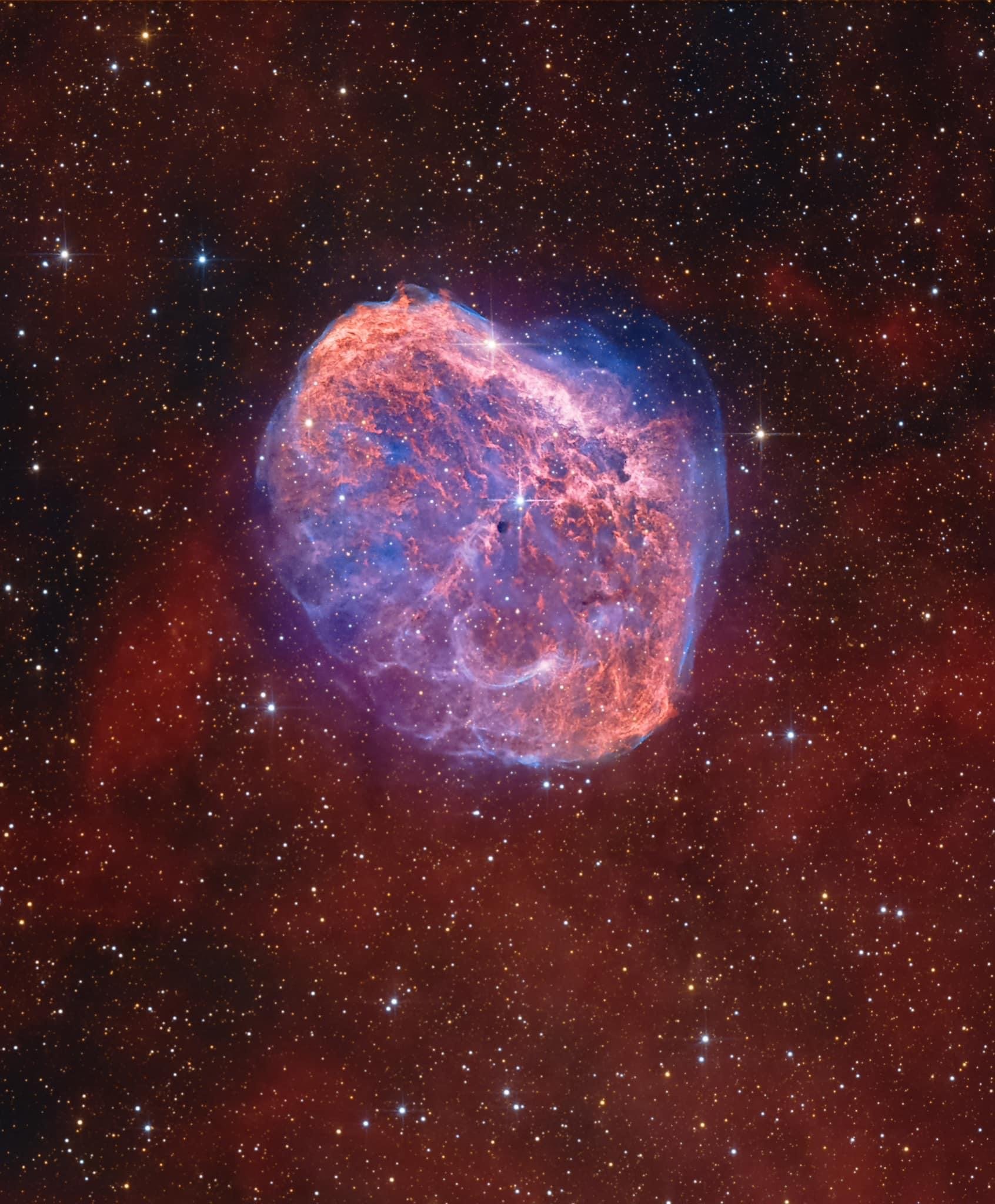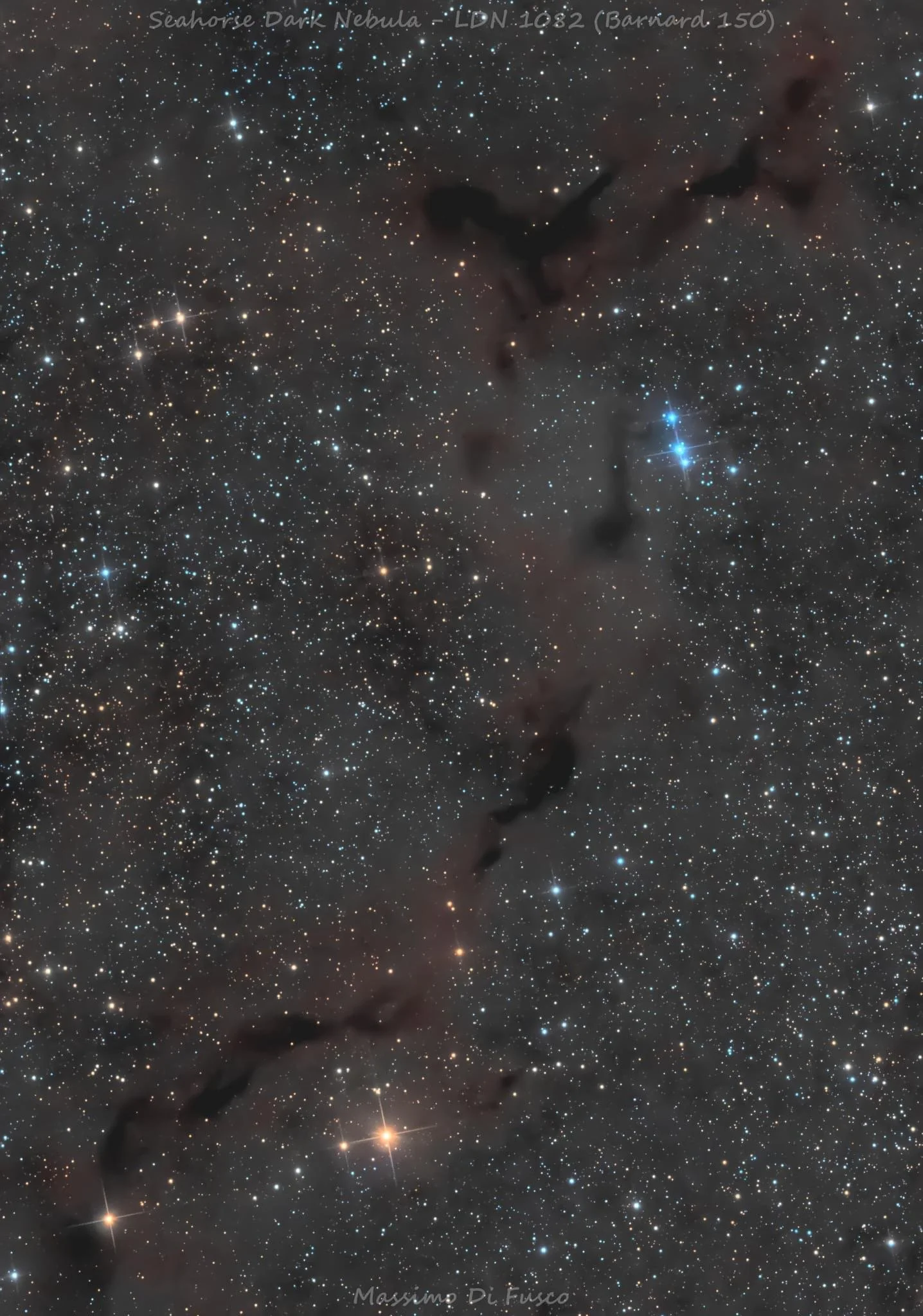
AAPOD2 Image Archives
Sort 2025 By Month: January | February | March | April | May | June | July | August | September | October | November | December
The Pencil Nebula NGC 2736
Image Description and Details : The Pencil Nebula is an emission nebula in the constellation Vela. It’s a small part of a supernova remnant that exploded about 11,000 years ago. The pencil-like shape suggests that it is part of the supernova shockwave that encountered a region of dense gas. It’s that intersection that causes the nebula to glow. The colors of the various regions in the nebula yield clues about this cooling process. Some regions are still so hot that the emission is dominated by ionized oxygen atoms, which glow blue/green in the picture. Other regions have cooled more and are seen emitting red in the image (cooler hydrogen atoms). In this situation, color shows the temperature of the gas.
The image was acquired over 9 days between 4/14/23 and 5/5/23 with total integration time of about 38 hours. It was processed in the HOO palette with RGB for the stars.
Ha - 233 x 300 secs
O3 - 197 x 300 secs
RBG - 8 x 300 sec each
Copyright: Daniel Stern
Thor's Lightning (SNR G150.3+4.5) with a new discovery MarSai Object 1
Image Description and Details : We have photographed the LDN 1400 object that hides the SNR G150.3+4.5, aka "Thor's Lightning."
A collaboration on data acquisition allowed us to highlight the SNR signal but also to unveil an OIII shell around the star "CI Camelopardalis".
The StDr team, which supported us on this project, analyzed our data and helped us to register this discovery, allowing us to open the Martino-Sainty Object (MarSai O) catalog
MarSai O 1 was named the "Angelo's Nebula", in homage to my father.
- Material and exifs from Nico:
RGB exifs: 269x300s
Alpha exifs : 83x600s
Takahashi FSQ85-EDX scope and ZWO ASI2400MC camera and Optolong L-Ultimate filter for the Hydrogen Alpha signal.
Sky-Watcher EQ6-R Pro mount driven by AsiAir Plus
- Yann's material and exifs :
Exifs Oiii : 60x600s
Takahashi FSQ106-EDX4 scope with reducer, and ZWO ASI2600MM camera and Antlia 3Nm 36mm filter
Sky-Watcher EQ6-R Pro mount driven via NINA.
Total integration 46h15
Pre-processing was done with Siril and post-processing with PixInsight and Photoshop.
Copyright: Nicolas MARTINO
Yann SAINTY
Team StDr
Gum 14/15 and the small planetary nebula He 2-11
Image Description and Details : Also the fourth stage of the ShaRA project, with which we occasionally go on a remote trip to the southern hemisphere to film some marvel of that marvelous sky, has recently concluded. ShaRA#4 was characterized by the multitude of shots taken but in this post I show you only the first part that featured the extended nebulae Gum 14 and Gum 15 and the small planetary nebula He 2-11, of which we made the first ever amateur shot and which we renamed the Spin Nebula.
Gum 14/15 are two little photographed nebulae in the constellation of Vela and apparently linked to each other. Gum 14, the largest, is an emission nebula excited by a class O blue supergiant and prospectively adjacent to a complex of reflection nebulae whose most important is NGC 2626. Gum 15 is another emission nebula which, together with Gum 14 belongs to the Vela Molecular Ridge: a mega molecular complex full of young and hot stars, which thanks to their radiation, becomes visible to our telescopes.
He 2-11 is a planetary nebula about 2300 light years away, with the rare peculiarity that its nucleus is characterized by a variable binary system. He 2-11 has a structure characterized by a uniform central core of OIII and two filamentous outer protuberances of low ionization H-alpha.
Copyright: Massimo Di Fusco (Team ShaRA
NGC 3572 and the Southern Tadpoles
Image Description and Details : I have taken this image in Ma5 2023, with my own equipment from the backyard of my house, in Posadas city, Argentina.
The data of the equipment used the details of the image are as follows:
Telescope: Skywatcher Esprit 150 ED Super APO Triplet
Cameras: QHYCCD 16200A
Mount: SkyWatcher EQ8-RH Pro
Guiding telescopes: SW Evoguider 50/250
Guiding camera: QHY5l II
Filters for Stars: Baader R - G - B
Filters for Nebula: Chroma OIII 3 nm - Antlia Ha 3 nm - Antlia SII 3 nm
Software: NINA - PHD2 - Pixinsight 1.8
Integration time: 15 h 15 min 30 sec
Copyright: Christian Hilbert
M 13 Hercules Globular Cluster
M 13 is 145 light-years in diameter and composed of between 300,000, to more than half a million gravitationally bound stars in the constellation of Hercules.
It’s a spectacular star cluster to see in a telescope with its super bright core of hot blue stars.
Imaged over 2 nights in May 2023 from my home in Gérgal, Spain., taken during almost a full Moon to test a new mount recently purchased.
Technical summary:
Captured: 03,04-05-2023
Imaging Sessions: 2
Location: Gérgal, Andalucía, Spain
Bortle Class: 4
Total Integration: 6h 50m
Filters:
Red 48x 91s 1h 31m BIN 2 Gain 100 0C SQM 19.5
Green 73x 60s 1h 13m BIN 2 Gain 100 0C SQM 19.5
Blue 78x 60s 1h 18m BIN 2 Gain 100 0C SQM 19.5
UV/IR 168x 60s 2h 48m BIN 2 Gain 100 0C SQM 19.5
Pixel Scale: 0.27 arcsec/pixel
Telescope: Celestron C11 Edge HD f/10 2800mm
Image Camera: ZWO ASI 6200MM Pro
Guiding: Omegon 60mm 240mm, ASI 183MC Pro
Filters: Astronomik R, G, B, UV/IR
Mount: iOptron CEM120 EC
Computer: Minix NUC
Capture software: NINA, PHD2
Editing software: PixInsight, Adobe Lightroom
Copyright: Eric Smith
Section of the Vela SNR in Narrowband Foraxx
Image Description and Details : A reprocess of the Southern Pinwheel Galaxy (M83,NGC5236) a barred spiral galaxy in the constellation borders of Centaurus and Hydra and approximately 15 million light years away.
93 x 180s subs shot @-10C taken over 2 nights using LRGB filters for an integration time of 4.5 hours.
For a higher resolution visit: https://www.astrobin.com/tykwqt/B/
Skywatcher 10" f4 Newtonian 250P
Skywatcher F4 Aplanatic Coma Corrector
Skywatcher NEQ6 Pro Hypertuned by Astronomy Academy Perth
ZWO ASI183MM Pro Cooled Camera
Primaluce Sesto Senso2 Electronic Focuser
ZWO Off Axis Guider
ZWO ASI290MM Mini Guide Camera
ZWO Electronic Filter Wheel
Antlia Pro 36mm unmounted filters
Rollon rolloff modified shed observatory
Bortle 5
Data acquisition software: NINA Astronomy Software
Processing software: PixInsight and Photoshop CC
Copyright: Capturing Ancient Photons
Pythagoras
Image Description and Details : Pythagoras is a prominent impact crater located near the northwestern limb of the Moon.
Pythagoras has a diameter of 130 km and its peak ascends 1.5 km above from the crater floor.
Celestron C9.25 XLT
ZWO ASI178MM
Tecnosky IR Pass 865nm filter
Acquisition, stacking and processing: Sharpcap/Autostakkert/Registax/Photoshop
Copyright: Antonio Grizzuti
Blue Whale Nebula (IC447, IC2169)
Image Description and Details : Area of beutiful reflection nebula, IC447
Looks like jewel box of winter milkey way.
Telescope: Skywatcher Quattro 150p
Coma Corrector: TSGPU
Mount: iOptron CEM70
Guide: Askar M54 OAG & ZWO asi174mm mini
Camera: ZWO asi2600mc pro & Touptek ATR3 CMOS 26000 KMA
Filter: Optolong L-Pro & Antlia V-Pro Luminance
Exposure:
RGB - 180" x 129
L - 60" x 156
Total 9h 3m
Copyright: SeulWoo Kim
M17 Omega Nebula
Image Description and Details : M17 Omega Nebula
The Omega Nebula (also known as the Swan Nebula, Horseshoe Nebula, Lobster Nebula or with the catalog codes M 17 and NGC 6618) is an emission nebula, discovered by de Chéseaux in 1746 and rediscovered by Charles Messier in 1764, located in the constellation Sagittarius.
Thanks to its luminosity, the Omega Nebula is quite easy to locate: it is located 2° southeast of the star γ Scuti. it can be identified quite easily even with 10x50 binoculars or even smaller, if the sky is dark and clear: in these instruments it appears as an elongated spot; through a 114 mm instrument, equipped with a UHC filter, it reveals a good part of its nuances and plays of light. From 200mm onwards the vision is exceptional, and it is advisable to take a long exposure photo to capture the rosy colour.
Constellation: Sagittarius
Right Ascension :18h 20m 26s
Declination : -16° 10′ 36″
Distance : about 6000 a.l.
Apparent magnitude: 6.0
This magnificent nebula was taken by my friend Gianni Lacroce. There are just under two hours of shots taken with a zwo ASI 2600 MC camera, a camera given to Gianni by a shopkeeper near Rome to test it. The owner had the doubt of a malfunction (later revealed not to be present). Talking about his performance, I asked him if I could elaborate these few shots and he kindly granted me the integration master.
Data:
Telescope: Newton 200/800
ZWO Astronomy Cameras asi 2600MC
Optolong Astronomy Filter L-ULTIMATE 2"
Mount: EQ6r
Location: Rome (Cinecittà)
21 lights of 300" total exp 1h45'
Flat, dark ok
Copyright: Mirko Tondinelli _ Gianni LaCroce
The Crescent nebula
Image description:
H-alfa data with RGB stars.
About 6h worth of data
Asi294mc
Azeq6 pro
Skywatcher 200/1000
L-extreme filter
Baader UV IR cut
Copyright: Cristiano Gualco
Ldn1082
LDN 1082 or Barnard 150, also known as Seahorse Nebula because of its striking appearance, is an extended, elongated dark molecular cloud of dust in Cepheus constellation, so thick, that it absorbs all the light that comes from the stars behind it. This molecular cloud is part of our Milky Way galaxy, one of the 182 objects cataloged by astronomer Edward E. Barnard and it lies at about 1200 Llight -years away. Cloud location on the Milky Way's plane, makes it stand out on the background completely filled with colorful stars of any age and size.
This nebula is about 1 degree in size, width of two Moons. What is also interesting about this cloud, as it have 3 highly dense dust cores, which actually is a star formation regions. They were cataloged by Lynds and named LDN 1082 A, B and C.
Because the molecular cloud is only illuminated from behind by starlight, it is a major challenge for astrophotographers to process the dark dust on a dark background. To make things easier, nebulae of this type require very dark skies, so I was skeptical about the success of the photo from a polluted city sky (Bortle 7, SQM 19). The result surprised me quite a bit, also considering that this nebula is still low in this period.
Konus 200/1000 @960mm, f/4.8
Qhy168c @-20 °C
Sky-Watcher Eq6r Pro mount
SvBony CLS filter 379x180"
N.I.N.A., DSS, APP, PixInsight, PS
Copyright: Massimo Di Fusco


